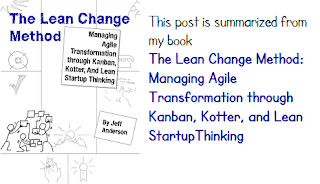
Often times when executives, managers, and consultants try to help technology organizations improve their agility they start with the method that they want to introduce.
Next they come up with a training plan, and rollout the method to the organization, maybe, a few pilots will be run before doing a big bag conversion to the new way of work.

This method first approach, is akin to hitting people over the head with the "agile stick". You are basically force-feeding a preconceived set of methods and tools onto employees.
This type of approach is guaranteed to foster resistance. It doesn't respect the fact that people identify themselves with the way they work, including their current methods and habits. Asking anybody to change without getting their input on to what that change should look like will never be more than superficially successful.

Avoid the agile stick, negotiate your way to successful change
There are still some in the agile world that do not realize that different organization will have different requirements, and a different organizational context. No two organizations will deliver value exactly the same way. Existing capability, market type, business domain, system architecture, organizational structure, etc., etc. will have a dramatic impact on both the journey and the destination of an agile or a lean inspired change.

This organizational uniqueness does not mean that a particular organization won't benefit from lean and agile principles, methods, and values. There are many flavors of agile and lean, and a whole library of methods and practices. Some are better suited to a more conservative, enterprise context, some for startups. Some methods recommend an incremental approach to change, some require a more big bang approach. Combining different aspects of different methods means that there is a lot of value that can be provided from the lean and agile world to the context of almost any application/software delivery oriented organization.

Agile change has a lot more chance of being successful if change agents can work through these various options with change stakeholders to come up with a solution that meets their exact context.
This often takes more time than simply rolling out a preconceived set of methods, but if care is taken to find the right set of early adopters, then a cocreative approach will vastly increase the odds that you do not end up with a change that nobody wants.

A cocreative approach also cuts down on resistance, knowledge workers often resist a new process simply because they were not included in helping to define how that process works.
Change stakeholders will learn much faster if they play a role in creating the solution, this improved learning helps eliminate resistance and create a shared responsibility for the change.

Negotiate a Change Solution Using a Change Canvas
A Change Canvas allows change agents to define a potential change using a concise language, a compact format, and a highly visual approach. This makes it easy to share a potential change solution to a larger number of change stakeholders, receive feedback on the change, and iterate as necessary to gain consensus on what a good change could look like, from both the perspective of where everyone wants to go, as well as how they want to get there.
The canvas articulates the key aspects of a potential agile change in a way that encourages communication and collaboration including:
- the urgency/reason for the change
- the change participants who are impacted by the change
- the suggested target state and vision
- the actions required to realize the change
- the commitments that change participants must make
- the benefits that change participants will receive
- the success criteria used to evaluate the outcome of the change

I have just heard an anecdote from a very senior agile coach who used the canvas to level set expectations on his involvement in the large-scale agile commission. He mapped out the statement of work onto the various components on the canvas, and asked his stakeholders if this was how they want to proceed. After several sessions, the stakeholders and iterate on the canvas to come up with a very different change model, one that they felt much more comfortable in owning and pursuing. A nice validation around the value of using the canvas to negotiate change.
For more check out The Lean Change Method: Managing Agile Transformation Through Kanban, Kotter, And Lean Startup thinking


No comments:
Post a Comment